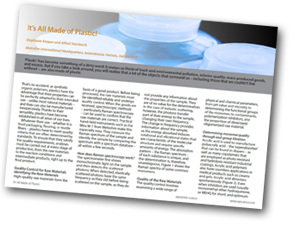‘Plastic’ has become something of a dirty word. It makes us think of trash and environmental pollution, inferior quality, mass-produced goods, and excess. But if you take a look around, you will realize that a lot of the objects that surround us – including those that we couldn’t live without – are also made of plastic.

 That’s no accident: as synthetic organic polymers, plastics have the advantage that their properties can be perfectly adapted to their intended use – unlike most natural materials – and they can also be manufactured inexpensively. Thanks to their versatility, plastics have become established in all areas of our lives.
That’s no accident: as synthetic organic polymers, plastics have the advantage that their properties can be perfectly adapted to their intended use – unlike most natural materials – and they can also be manufactured inexpensively. Thanks to their versatility, plastics have become established in all areas of our lives.
Whatever their use – whether it is food packaging, flooring, or textile fibers – plastics have to meet quality criteria that are often determined by standards. To ensure that they satisfy the quality requirements, analyses must be carried out at every stage of production, from the raw materials to the reaction conditions and intermediate products, right up to the final product.
Quality Control for Raw Materials
High-quality raw materials form the basis of a good product. Before being processed, the raw materials must be identified reliably and undergo quality control. When the goods are received, spectroscopic methods – particularly Raman spectroscopy – can be used to confirm that the raw materials are correct. Practical hand-held instruments such as the Mira M-1 from Metrohm make this especially easy. They measure the Raman spectrum of the sample and identify the sample by comparing the spectrum with a spectrum database – all within a few seconds.
The spectrometer first shines monochromatic light on the sample and then detects the scattered photons. When detected, elastically scattered photons have the same frequency as they did before being scattered on the sample, so they do not provide any information about the properties of the sample. They are of no value for the determination. In the case of inelastic scattering, however, the photons transfer part of their energy to the sample, changing their own frequency. The change in frequency provides information about the sample, as the energy absorbed induces rotational and vibrational states that are characteristic of the molecular structure and require specific amounts of energy. The absorption pattern – the Raman spectrum – of each substance is unique, and the determination is, therefore, unambiguous.
Quality of the Raw Materials
The quality control involves examining a wide range of physical and chemical parameters, from pH value and viscosity to determining the functional groups of the monomer, to contaminants, polymerization inhibitors, and the proportion of dimerized/ oligomerized raw material.
To read the full article click on the button below...




